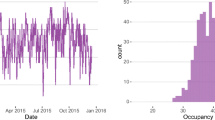Abstract
A project schedule contains a network of activities, the activity durations, the early and late finish dates for each activity, and the associated total float or slack times, the difference between the late and early dates. Here I show that the distribution of activity durations and total floats of construction project schedules exhibit a power law scaling. The power law scaling of the activity durations is explained by a historical process of specialization fragmenting old activities into new activities with shorter duration. In contrast, the power law scaling of the total floats distribution across activities is determined by the activity network. I demonstrate that the power law scaling of the activity duration distribution is essential to obtain a good estimate of the project delay distribution, while the actual total float distribution is less relevant. Finally, using extreme value theory and scaling arguments, I provide a mathematical proof for reference class forecasting for the project delay distribution. The project delay cumulative distribution function is \(G(z) = \exp ( - (z_c/z)^{1/s})\), where \(s>0\) and \(z_c>0\) are shape and scale parameters. Furthermore, if activity delays follow a lognormal distribution, as the empirical data suggests, then \(s=1\) and \(z_c \sim N^{0.20}d_{\max }^{1+0.20(1-\gamma _d)}\), where N is the number of activities, \(d_{\max }\), the maximum activity duration in units of days and \(\gamma _d\), the power law exponent of the activity duration distribution. These results offer new insights about project schedules, reference class forecasting and delay risk analysis.
Graphic abstract
A process of activities duration fragmentation explains the emergence of scaling in the activities duration distribution.








Similar content being viewed by others
Data Availability
The projects in the Nodes & Links contain sensitive information about the associated sources. While we can release statistics and analyses about that data, we are not authorized to release the raw schedule data. The code for the duplication-split model is available at github.com/av2atgh/red.
References
Project Management Institute. A Guide to the Project Management Body of Knowledge(PMBOK Guide). PMI Global Standard, 4th edn. (Project Management Institute, 2010)
M. Vanhoucke, Project Management with Dynamic Scheduling: Baseline Scheduling, Risk Analysis and Project Control (Springer, Berlin, Heidelberg, 2013)
C. Ellinas, The Domino effect: an empirical exposition of systemic risk across project networks. Prod. Oper. Manage. 28, 63–81 (2019)
M. Santolini, C. Ellinas, C. Nicolaides, Uncovering the fragility of large-scale engineering projects. EPJ Data Sci. 10(1), 36 (2021)
I. Pozzana, C. Ellinas, G. Kalogridis, K. Sakellariou, Spreading of performance fluctuations on real-world project networks. Appl. Network Sci. 6, 25 (2021)
A. Vazquez, I. Pozzana, G. Kalogridis, C. Ellinas, Activity networks determine project performance. Sci. Rep. 13(1), 509 (2023)
P.L. Krapivsky, E. Ben-Naim, Scaling and multiscaling in models of fragmentation. Phys. Rev. E 50, 3502–3507 (1994)
O. Sotolongo-Costa, Y. Moreno-Vega, J.J. Lloveras-González, J.C. Antoranz, Criticality in droplet fragmentation. Phys. Rev. Lett. 76, 42–45 (1996)
Jung Eun Park, Schedule delays of major projects: what should we do about it? Transp. Rev. 41(6), 814–832 (2021)
A. Vazquez, Tropical approximation to finish time of activity networks. Phys. Rev. E 106, L012301 (2022)
David Hulett, Practical Schedule Risk Analysis (Routledge, London, 2016)
A. Vazquez, C. Marasinou, G. Kalogridis, C. Ellinas, Activity delay patterns in project networks. Phys. A Stat. Mech. Appl. 637, 129570 (2024)
S.I. Resnick, Extreme Values, Regular Variation and Point Processes Springer Series in Operations Research and Financial Engineering. (Springer, New York, NY, 1987)
B. Flyvbjerg, From Nobel Prize to Project Management: Getting Risks Right. Proj. Manage. J. 37(3), 5–15 (2006)
A. Natarajan, Reference class forecasting and machine learning for improved offshore oil and gas megaproject planning: methods and application. Proj. Manage. J. 53(5), 456–484 (2022)
B. Flyvbjerg, A. Budzier, J.S. Lee, M. Keil, D. Lunn, D.W. Bester, The empirical reality of it project cost overruns: discovering a power-law distribution. J. Manage. Inf. Syst. 39(3), 607–639 (2022)
R. Baerenbold, Reducing risks in megaprojects: the potential of reference class forecasting. Project Leadership Soc. 4, 100103 (2023)
X. Liao, Z. Peng, Convergence rates of limit distribution of maxima of lognormal samples. J. Math. Anal. Appl. 395(2), 643–653 (2012)
Acknowledgements
I thank the data science team at Nodes & Links, in particular Hidayet Zaimaga and Georgios Kalogridis, for the generation of the construction project schedules database.
Funding
This research did not receive any specific grant from funding agencies in the public, commercial, or not-for-profit sectors. Nodes & Links Ltd provided support in the form of salary for A.V., but did not have any additional role in the conceptualization of the study, analysis, decision to publish, or preparation of the manuscript.
Author information
Authors and Affiliations
Contributions
A.V. conceptualized and executed the work.
Corresponding author
Ethics declarations
Conflict of interest
The author declares that he has no conflict of interest.
Rights and permissions
Springer Nature or its licensor (e.g. a society or other partner) holds exclusive rights to this article under a publishing agreement with the author(s) or other rightsholder(s); author self-archiving of the accepted manuscript version of this article is solely governed by the terms of such publishing agreement and applicable law.
About this article
Cite this article
Vazquez, A. Emerge of scaling in project schedules. Eur. Phys. J. B 97, 44 (2024). https://doi.org/10.1140/epjb/s10051-024-00676-6
Received:
Accepted:
Published:
DOI: https://doi.org/10.1140/epjb/s10051-024-00676-6




